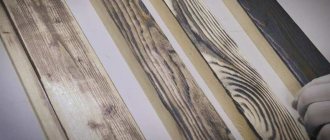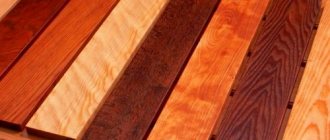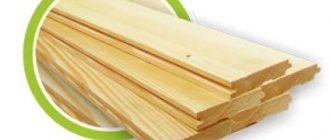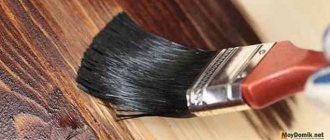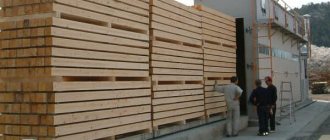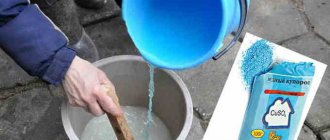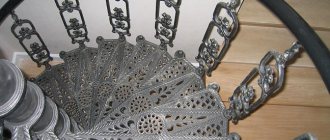Main goals of stabilization
The primary task is to protect the wood from the negative effects of moisture.
After impregnation, the fibers become impervious to all kinds of liquids and chemical treatments. They do not increase, do not lose their performance characteristics, and retain their shape and color. This procedure is not just impregnation, but filling the entire available space between the fibers. For this purpose, protective compounds are used that clog pores.
Stabilization helps improve the consumer qualities of wood. The best effect can be achieved with compositions that have the ability to polymerize. Most often used for this purpose:
- natural resins,
- polymers,
- paints and varnishes,
- all kinds of oils.
Filling table
Such furniture production is considered labor-intensive. The basis is thick glass and a piece of plywood in the shape of the desired table.
Lightweight parts of the design are glued to prevent them from floating up. It is necessary to make a side so that the mixture does not spread. The side is nailed with small nails.
Before pouring, check that the base is dry. The tree is covered with a soil mixture; a layer no thicker than 1 centimeter can be poured at a time.
If there are large parts, they are poured in several stages. This product can be put into operation within a week.
After this time, it will be sanded and polished again from the beginning, if necessary. It is also recommended to varnish such products to avoid defects.
Peculiarities
Epoxy resin is a purely synthetic compound substance in liquid form. Undiluted, it can be stored for a very long time, therefore, before pouring into molds, it is mixed with another liquid - a hardener - in the proportion as indicated on the packaging. Only such mixing starts the polymerization processes, which means that the mixed mass must be given the desired shape as quickly as possible.
Products made from epoxy resin are used in a wide variety of industries, including even electronics and aviation, but in combination with wood, this material is, of course, the most practical for the DIY production of home furniture or souvenirs and small utensils.
Epoxy resin in combination with wood is good because it initially has a fluid form and is able to fill any cracks and chips, leveling out the unevenness of the wood purely under the influence of the laws of physics. After hardening, its surface lends itself well to grinding and polishing; grooves can be turned into it or holes can be drilled. In this case, the material can be purchased in a specific color or completely transparent, and the latter can be tinted with commercially available dyes.
Properties of epoxy glue
It has a number of positive properties, which include:
- versatility of use, glues metal, glass, wood, plastic products and rubber without deforming the material;
- resistance to chemically active substances (oils, varnishes, alkalis, solvents);
One example of using glue Source practeco.ru
- elasticity and viscosity are provided by plasticizers;
- resistance to high and low temperatures, maintains quality up to +250°C, used at low temperatures down to -20°C;
- maintaining density and strength, does not shrink after hardening, prevents cracks and tears in layers, reliably connects materials to each other;
- moisture resistance, used for waterproofing, as it does not allow water to pass through;
- efficiency, solves any repair problem;
- drying speed (from 2 minutes to several hours);
- dielectric properties - does not conduct current;
- breadth of application - indispensable for household repairs and industrial needs.
The disadvantages of the glue are that it sets too quickly and is prohibited from working with surfaces made of silicone, Teflon and polyethylene.
Why do you need to impregnate wood?
Wood is in great demand due to its strength, environmental friendliness, hygroscopicity, sound insulation and heat capacity. In addition, the beauty and ease of wood processing place it much higher than other materials in the manufacture of furniture, construction, finishing of houses and industrial premises.
Untreated wood is destroyed under the influence of many factors, so numerous impregnations and antiseptics have been created that protect the material:
- from fungi,
- from mold,
- from rot,
- from insects,
- from ultraviolet radiation,
- from temperature changes,
- from precipitation,
- from various injuries,
- from penetration and sedimentation of dirt.
Selection of material
In order for a particular material to be freely used when pouring products, it is necessary that the epoxy has good adhesion to this material. In simple words, they must “stick together” well. Otherwise, peeling may occur inside the polymer, which will negatively affect the appearance of the product. In this regard, wood combines well with resin, but several nuances of pouring must be taken into account.
To fill floors, you need to focus on the strength indicator. For the manufacture of tabletops, the fluidity of the compound is important, and decorations and souvenirs are excellent from transparent resin. The epoxy composition is easy to prepare at home. The resin is usually sold as two components in a kit. The base composition may be called component “A”, and the hardener may be called component “B”. When they are mixed, a chemical reaction occurs. As a result of polymerization, a substance is formed that retains its shape and volume.
The reaction of interaction of oligomers with the hardener occurs with the release of heat. An intense reaction can cause the resin to become overheated and even boil. To avoid this, you should not work with large volumes if you do not have the skill to handle materials. The larger the volume, the more energy is released as a result of the reaction.
Another parameter on which the intensity of interaction of reagents depends is the lifetime of the resin. Many people try to choose resins that have a minimum lifetime. They motivate their choice by the fact that in this way they can reduce the hardening time of the compound, but this is a mistaken opinion.
- Firstly, the time for complete cure is independent of the pot life.
- Secondly, the long lifetime corresponds to a less intense reaction, therefore eliminating overheating of the resin.
When stirring, many air bubbles appear in the resin. If they do not come to the surface, they will remain in the frozen compound and spoil the whole picture. Experienced professionals can remove bubbles, but it is recommended that all possible measures be taken to reduce their number.
If appropriate equipment is available, vacuuming is used. By lowering the air pressure above the resin, an accelerated release of bubbles from the resin is achieved. The remaining bubbles are dealt with after pouring by heating the epoxy with a hairdryer.
Composition of the substance
The main components of epoxy adhesive consist of resin, special hardeners and additional components. The adhesive composition is represented by hardeners, solvents and other substances.
Hardeners (up to 15% of the total composition):
- polyamine;
- carboxylic acids;
- anhydrite;
- polyethylene polyamine;
- organophosphorus modifiers;
- laproxy;
- aminoamide
Proportions of adhesives Source gidpokraske.ru
Solvents (up to 3%):
- acetone;
- alcohol;
- xylene
Other substances:
- metal oxides;
- chalk;
- fiberglass;
- formaldehyde;
- metal powder;
- clay;
- synthetic rubber.
Additional components improve the characteristics of the adhesive composition, making the seams of the joined surfaces harder and more durable. Experienced craftsmen add industrial additives to the composition:
- Aluminum (powder). Positively affects strength and thermal conductivity.
- Silica. Gives viscosity and strength.
- Asbestos. Produces hardness and resistance to temperature changes.
- Iron powder. Gives seams a reddish tint, increases fire resistance and thermal conductivity.
- Titanium dioxide. Capable of turning transparent color into white.
- Soot. Used for painting seams in a dark shade (asphalt, black).
- A combination of glass fibers and wood chips. Adds volume to the mixture to fill large voids.
A large role in the composition is given to plasticizers - phosphoric and phthalic acids. Polymers and oligomers regulate the technical properties of the adhesive, ensuring reliable installation.
Resin preparation
By combining different volumes of polymer compound with a hardener, you can obtain all kinds of compositions for creativity, design or finishing work. The typical ratio is 10:1. It is convenient for making crafts. In order to strengthen the surface, the proportion should be 5:1.
Technologies for preparing small and large volumes of the working mixture differ. The polymerization process is accelerated by increasing the temperature. It is necessary to correctly select the components of the working substance. You need to start by heating the compound in a water bath to reduce the viscosity of the material.
Pour the hardener into the hot resin in a thin stream, stirring constantly. An amine- or anhydride-based chemical is suitable for dissolving the compound. This composition begins to harden after 30-40 minutes. Therefore, you need to work right away.
When preparing a large volume of polymer compound, plasticizers are added. Their correct content is 5-10% by weight of epoxy. This mixture should boil. A construction mixer is used for mixing. If you want to add color to the composition, add the appropriate pigment. Before mixing with the hardener, the resin is cooled to 30°C.
How to remove bubbles from air
It happens that it was not possible to carry out work without the appearance of bubbles. There is no need to heat the object, otherwise bubbles may appear again.
The best way is to take a thin needle and pierce each ball. Or take a spray bottle of alcohol and sprinkle it on the surface with bubbles.
Although in this case the surface may change color or become less transparent. If the balls are large enough, then after complete hardening they are drilled, cleaned and refilled.
Bodies of revolution
Let's look separately at the category of wood crafts. This may include jewelry, furniture items or souvenirs. What they have in common is that they are obtained by turning them on a lathe.
At first glance, it may seem that these are the most complex crafts in terms of manufacturing technology. But the high degree of adhesion of the resin makes it possible to process wood together with epoxy as a single piece.
Pine timber is used as the starting material. It usually has cracks that occur when the wood dries. These cracks will subsequently play an important role in decoration. If desired, you can distribute them using a grinder. Tinted resin is poured into the resulting cavities. To prevent it from leaking out of the end parts of the beam, it is necessary to take all possible sealing measures. Even temporary structures are suitable, because after the resin has cured they can be removed.
The piece of timber and resin is then processed on a lathe. This is just one of many examples. Here the master has the opportunity to show his imagination.
Jewelry with dry plants and flowers
To create such decorations, it is necessary to prepare flowers. Forget-me-nots, buds, petals, and heather look very original and cute. First, a stencil is drawn out on paper, then it is placed on a base in film. The stencils are coated with multiphores.
Next, pour the prepared epoxy directly on top, pouring it evenly over the entire stencil, making a layer of 3 centimeters. Then a dome-shaped form is placed on top (this option is suitable for making earrings or pendants).
They leave everything for a day, then remove the mold, remove it from the multifora, sand it and glue it together.
Details
Preparatory stage before applying paintwork
If the mixture is of a two-component type, then it should be properly prepared before application. A hardener should be added to the base, and then the mixture should be thoroughly mixed for 5-10 minutes. Next, you should wait a couple more minutes for the chemical reaction to complete, and at this time some types of varnishes become a little whitish. Once all the air bubbles have come out, you can begin applying the solution. You should immediately remember that epoxy-polyurethane varnishes have a certain pot life, and it usually ranges from 1 to 2 hours. During this time, you should have time to apply the entire prepared and diluted mixture. If you need to varnish large surfaces, then prepare the solution in batches. After every 20 minutes, the prepared composition should be mixed.
Varnishing rules
The procedure for applying two-component epoxy varnish to parquet or concrete can be carried out using a spray gun or manually - with a roller or brush. The varnish composition should be applied at temperatures from +5 to +30 degrees, and air humidity should be less than 80%. Under no circumstances should there be dew or condensation on the treatment surface, and the surface temperature should not be allowed to be lower than +5 degrees. The varnish usually dries after 8-13 hours, and complete polymerization occurs after about 48 hours if the air temperature is approximately +20 to +25 degrees.
The best method of application is, of course, spraying from a spray bottle, but if you still don’t have a spray gun, then you can use wide rollers. Please note that the wider the roller, the better, since the varnishing process will be easier and faster. When applying the composition to a concrete or parquet floor surface, you should not go over the same place twice, and thanks to this the coating will be the same in thickness and homogeneous. If varnishing is done with a roller, then ideally you should make cross-shaped movements. Due to transverse movements, the varnish will be applied to the floor, and longitudinal movements will level the applied solution. Near walls and columns, as well as other obstacles, the application speed should be reduced. Before you start varnishing, the roller should be rolled out.
Expert advice
When treating parquet, concrete or wooden floors with varnish, you should definitely follow these simple recommendations from experts in their field:
- Varnish preferably in several layers, and ideally you should apply varnish at least 3 times. The number of coatings will largely depend on how intensively the room will be used, what loads the varnish can withstand, and also what characteristics the surface being treated has.
- Before applying the final coat of varnish, the surface should be sanded a little.
- It is imperative to adhere to the same consumption over the entire surface area of the treatment, this is approximately 0.12 kg per square meter, and if the consumption is less, the varnished layer will be fragile; If the application turns out to be stronger, the varnish will begin to wrinkle.
- The varnishing process should be carried out in a respirator, which has a special insert that is capable of absorbing organic vapors. During the drying process, epoxy varnish is capable of releasing toxic and harmful fumes for human health, and it is from them that the respiratory organs should be protected.
If you follow these tips, the varnished coating will be durable and durable. Externally, it will look beautiful, shiny, and will reliably protect the treated base for many years.
Why is impregnation done?
Heterogeneity of the structure of the tree, especially in northern species, which overwinter by shedding their leaves, or, in the case of coniferous species, slow down their life processes in the cold season. On their transverse cuts and sections, annual rings are clearly visible, and on longitudinal cuts, alternating tangential patterns from light and darker sections of wood.
When drying (a natural process for wood products), cuts and cuts become slightly ribbed, this is the result of uneven evaporation of moisture from them, when denser light areas begin to protrude above the surface, and looser dark ones sink deeper due to faster evaporation of moisture from them .
But the light areas also have a loose structure, they just have fewer pores than the dark ones. Over time, this causes problems with the safety of wood products. Wood-boring parasites penetrate them, and fungal or bacterial infection should not be discounted. The result is the transformation of the tree into dust and rot. To get rid of such destructive factors, they make all kinds of impregnations: bactericidal, preserving and cementing the structure of wood cells.
Products for protecting wood from moisture
The consequences of keeping a tree in conditions of excessive waterlogging are:
- reduction in performance properties;
- spread of mold outbreaks;
- the appearance of fungus.
There are several types of exposure to humidity:
- rain and snow precipitation;
- formed condensate;
- moisture coming from a specific source.
Protection from wood moisture is ensured even at the procurement stage. It should be noted that different types of wood react differently to humidity. The most stable in terms of this parameter are:
- larch;
- ash;
- pine;
- oak.
Wood that is moderately resistant to waterlogging:
- spruce;
- fir;
- beech.
Some types of tropical wood require little or no processing.
Wood varieties differ in the level of intracellular moisture. In the construction industry, raw materials with an indicator of approximately 15% can be used. The recommended humidity of the material used to create the truss structure is about 13%. External cladding requires the selection of raw materials with fifteen percent moisture content.
It is possible to reduce hygroscopicity using several types of means to protect wood from moisture:
- varnishes;
- oil compositions;
- paste
Solutions that form a film coating cannot be called durable. Because of this, there is a need for regular processing. Penetrating formulations, on the contrary, provide a longer lasting effect. Walls of residential buildings and garden furniture are treated with such preparations.
The use of a water repellent does not distort the shade. The coating layer is able to protect the building material, preventing liquid from penetrating into the structure. Often this type of solution can provide good frost resistance.
Work system
Before you start choosing a suitable covering for a heated floor, you need to obtain basic knowledge about the operation of this heating system. There are four types of electric heated floors:
- Cable heating system.
- Heating mats.
- Infrared emitter in the form of a film.
- Electrical systems using liquids.
Cable heating is based on the Joule-Lens law, according to which conductors release thermal energy when electricity is applied to them. When installing electrical wiring, engineers try to select materials that minimize the amount of heat generated, and when installing underfloor heating from cables, they use highly heated elements. At the same time, they try to choose durable materials that can work for a long time.
The main advantage of electric heated floors is the ability to install them in apartments of apartment buildings where it is not possible to install water floor heating.
Which impregnation is better
A wide range of products can make choosing in favor of any one difficult, so you need to immediately differentiate the desired effects from the composition
In addition, it is important to correctly use liquids for the type of interior or exterior work.
For interior work
When choosing an impregnation for treating wood that will be or has already been installed indoors, first of all, pay attention to the environmental friendliness and safety of the solution. Water-based products containing natural solvents and oils meet these requirements.
Conventionally, all products in this line can be divided into 3 groups:
- antiseptics, which are designed to protect against rotting, mold and mildew, temperature changes, changes in shape and color;
- moisture-proof, which are used to treat baths to protect the array from constant exposure to high temperatures and moisture;
- fire retardant, significantly or completely reducing the risk of fire.
For outdoor use
When processing wood that will constantly be outdoors and exposed to various harmful and atmospheric factors, it is recommended to use more aggressive impregnations. At the same time, harm to health and environmental friendliness, due to the work being carried out outdoors, fade into the background.
First of all, antiseptic impregnation is used, which will not only prevent various microorganisms from living and multiplying in the structure of the tree, destroying it, but will also preserve its appearance, since during the life of bacteria and fungi the material turns black.
If the surface has previously been given the desired shade, the impregnation should protect against ultraviolet radiation.
Description and characteristics of epoxy glue
This product is widely used for household and industrial purposes, and is a popular synthetic substance included in tile mixtures, putty and primers. The adhesive is a combination of epoxy resin, polymers and solvent, the percentage of which is established by the technical nomenclature.
Thanks to its unique polymer composition, the product is used to bond different dense surfaces. You can use epoxy glue for metal, rubber, wood, concrete, leather, plastic.
The adhesive composition is sold ready-made or requires preparation: it can be liquid or thick (clay-like). Liquid is available in tubes, and plasticine is presented in bars of different sizes.
The technical characteristics of the glue are as follows:
- strength 100-400 kgf per 1 m2;
- polymerization time – 2 min – 3 h;
- operating temperature -20...+120°C (sometimes up to 270°C), best performance indicators - from +10°C to +25°C;
- hazard class – 3 (low hazard), but may cause skin allergies;
- average density per 1 m3 – 1.37 t;
- the shade can be transparent, white, gray, pink, silver, brown;
- average consumption 1 m2 – 1.1 kg;
- environmentally friendly, not recommended for gluing dishes (considered toxic).
Characteristics and instructions for use Source kraskaguru.ru
- sales form, available in tubes of 45-70 ml, syringes of 6-25 ml, packaging construction buckets, bottles, containers of 140, 250, 500 mg, 1 kg; industrial barrels 15-19 kg;
- storage is carried out in a dry place in a vertical position, requires the integrity of the packaging;
- shelf life 12-36 months.
The glue is easy to apply, tightly fixes surfaces and fills pores, forming a durable seam that is resistant to temperature changes and water. Requires application in a slightly heated form, as it does not like low temperatures.
Important! The technical component of epoxy glue meets the requirements of UP-5-233, TU 6-05-241-366. And for resin content: GOST 10587–84, main solvent (acetone): GOST 27890-88, for safety: GOST 12.1.007-76.
Protective agents for impregnation
All means by which wood is reliably protected have excellent characteristics. In this case, the tree that is being processed is classified into separate groups:
Impregnation using the “vacuum-pressure-vacuum” technology is a reliable means of protecting wood for a long time.
- difficult to impregnate - these are ash, fir, beech, Siberian larch, spruce heartwood, spruce sapwood, elm;
- with moderate impregnation - these are pine, alder, aspen, linden, maple, hornbeam, oak, larch, cedar sapwood;
- easily impregnated - this is birch, ordinary pine (sapwood).
When choosing a composition for impregnation, it is necessary to take into account the group of material, since the solution simply will not be able to penetrate inside to the required depth.
The following are used as protection compounds:
- brush solutions;
- solutions for immersion in baths (short and long term);
- solutions for spraying onto the surface of the material;
- compositions for working in vacuum conditions, under high pressure;
- diffusion impregnations;
- solutions for hot and cold baths.
Application area
Good technical characteristics allow for a wide range of applications of epoxy adhesive:
- in construction - glues solid objects and concrete, is used as a cold weld for gluing plastic pipes, plastic products, seals seams in panel houses, is a good sealant and insulation;
Glue for pouring during PC repair Source forum.modding.ru
See also: Catalog of companies that specialize in finishing materials
- in everyday life it is suitable for repairing electronics, appliances, jewelry, leather goods, furniture;
- mechanical engineering and auto repair copes with cracks, chips, and various minor defects;
- in aircraft manufacturing and shipping it is used as a waterproof coating;
- the production of souvenirs and accessories allows you to create cultural masterpieces in the souvenir and furniture industry;
- in electricity, dielectric properties allow the use of glue when installing electrical networks.
Due to its unique properties, glue is in demand for many industries and areas, with the exception of dishes. The polymers contained in the composition can cause food poisoning.
Types of impregnations depending on their base
Any protective impregnation is intended for different purposes and places of use. In this regard, a special composition is being developed based on the main component. Thanks to the combination of additional agents, impregnations may or may not have a smell, differ in consistency and color, create a film on the surface of the wood or completely penetrate the pores of the material being treated.
Water based
Water-based impregnations are available in completely finished form. They are distinguished by the absence of an unpleasant odor, so they are suitable for both external and internal work.
A water base means applying the product even to a damp surface or to salt coatings, the combination of which is ineffective with solvent-based liquids.
Application is carried out with a brush or spray, using the vacuum method by soaking. The product dries quickly and penetrates deeply into the wood, but has one limitation - it cannot be used to process old, dry material. This leads to swelling of the latter and the formation of cracks on it.
According to their intended purpose, substances can have antiseptic, fire-fighting and decorative properties, and protect against getting wet. They have lower wear resistance compared to other products.
Acrylic based
Acrylic-based impregnations are used to protect and decorate wooden surfaces both outside and inside. They are environmentally friendly for humans and odorless.
Such mixtures have strengthening and water-repellent properties and can perfectly protect against fungus, mold and rot. After applying impregnation, the service life of the material increases.
The array can be processed at any stage of construction. Apply the product with a brush or spray.
The disadvantages of acrylic impregnations include intolerance to low temperatures.
Salt based
Salt impregnations are available in powder or ready-made solution form. They are most often used to treat rafter systems to protect them from fungi, mold and pests. In addition, due to the settling of salt crystals, such products effectively protect against fire.
Application with a brush is possible, but the greatest effect can only be achieved by soaking or processing in a vacuum chamber. For this reason, mixtures are rarely used in everyday life, but such processing can be ordered in production.
Oil based
Oil impregnations have high water-repellent properties. They are actively used to cover wooden structures and furniture that are located outdoors and are constantly exposed to precipitation.
The oil in the base of the product penetrates deeply into the fibers of the array, preventing it from drying out and cracking, as well as exposure to dirt and dust. The product treated with impregnation slightly changes color, while acquiring a beautiful shiny surface.
This coating is not durable. It must be renewed every year, applying with a spray or brush in several layers.
Disadvantages include the flammability of the mixture and the inability to apply other products on top of it.
Based on alkyd resins
Alkyd impregnations contain antiseptic additives, oil and wax. The mixtures perfectly highlight the natural beauty of wood, protect it from mold, fungi and exposure, both atmospheric and physical.
After application with a brush or roller, there is a long drying time, which many consider to be a significant drawback of such a product.
Bitumen based
Bitumen impregnation is a thick black mass. The mixture is based on gasoline and diesel fuel. Most often, the product is made independently and is intended exclusively for external work due to its high toxicity and pungent odor.
Any type of wood can be processed, even dried. After application, a dense protective layer is formed that prevents the development of harmful bacteria and fungi and insect attacks.
The composition implies protection from moisture, but high flammability.
Silicone
Silicone impregnation has all the positive characteristics of other types of products: water-repellent, antiseptic, protects against ultraviolet radiation and biological destruction. In this case, the mixture does not form a film, allowing the array to breathe.
Apply in any convenient way. Sold as concentrated or simple liquids.
Stabilization technology from the masters of the Solovetsky Monastery
As you know, this monastery was built of wood. Over the centuries, some elements of the buildings of the monastery block have not been adversely affected by the atmosphere, moisture and time. Some details even violate all the laws of physics. But everything turned out to be very simple - it’s salt.
For many centuries, people have never ceased to admire the beauty of wood and try, as far as possible, to protect the tree from aging and rotting. For this purpose, many impregnations, antiseptics, and fire retardants are produced that can reduce the harmful effects of the environment and extend the life of the product. The most modern method is vacuum impregnation.
Using this technique allows the protective composition, due to reduced pressure, to penetrate to a depth of up to 5 cm, depending on the type of wood and the technique used. In comparison, conventional brush or roller application achieves a penetration of up to 2mm.
Wood processing
It is recommended to pre-impregnate dry timber with a primer; the working composition is diluted by half. If the humidity of the frames or blanks is at least 22%, the wood is immediately treated with liquid glass. To calculate the required amount of solution, an average consumption of –300 g/m2 is taken. Liquid glass is diluted only before work and mixed thoroughly.
Treatment is carried out at any time of the year, at air temperatures not lower than -20°C, not higher than +40°C. The mixture is applied with a felt brush or felt roller in the direction of the fibers. Small parts are easier to handle by dipping.
Treatment is carried out at any time of the year, at air temperatures not lower than -20°C, not higher than +40°C.
